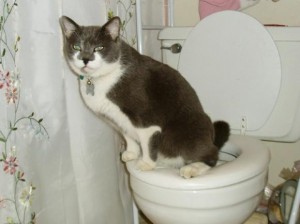Potential Risks of Flushing Cat Poop Down Your Toilet - Advice for Better Handling
Potential Risks of Flushing Cat Poop Down Your Toilet - Advice for Better Handling
Blog Article
Everybody may have their unique assumption when it comes to Don’t flush cat feces down the toilet.

Introduction
As pet cat owners, it's necessary to bear in mind just how we take care of our feline good friends' waste. While it may seem hassle-free to purge feline poop down the toilet, this technique can have damaging repercussions for both the setting and human health.
Alternatives to Flushing
Luckily, there are safer and extra accountable means to throw away pet cat poop. Think about the following options:
1. Scoop and Dispose in Trash
The most typical method of taking care of feline poop is to scoop it right into a naturally degradable bag and toss it in the trash. Be sure to make use of a devoted clutter scoop and take care of the waste quickly.
2. Usage Biodegradable Litter
Choose eco-friendly feline clutter made from materials such as corn or wheat. These clutters are eco-friendly and can be safely dealt with in the garbage.
3. Hide in the Yard
If you have a lawn, consider hiding pet cat waste in a marked location away from veggie gardens and water sources. Make certain to dig deep adequate to stop contamination of groundwater.
4. Mount a Pet Waste Disposal System
Buy an animal garbage disposal system specifically created for pet cat waste. These systems use enzymes to break down the waste, minimizing smell and environmental influence.
Wellness Risks
In addition to environmental worries, purging cat waste can likewise present wellness dangers to human beings. Pet cat feces might contain Toxoplasma gondii, a parasite that can trigger toxoplasmosis-- a possibly serious ailment, particularly for expecting women and people with weakened body immune systems.
Ecological Impact
Purging pet cat poop presents harmful microorganisms and parasites into the water system, presenting a substantial danger to water environments. These impurities can adversely affect aquatic life and concession water high quality.
Verdict
Liable pet dog possession expands beyond providing food and shelter-- it also involves correct waste monitoring. By avoiding purging feline poop down the bathroom and selecting alternate disposal techniques, we can lessen our environmental footprint and safeguard human health.
Why Can’t I Flush Cat Poop?
It Spreads a Parasite
Cats are frequently infected with a parasite called toxoplasma gondii. The parasite causes an infection called toxoplasmosis. It is usually harmless to cats. The parasite only uses cat poop as a host for its eggs. Otherwise, the cat’s immune system usually keeps the infection at low enough levels to maintain its own health. But it does not stop the develop of eggs. These eggs are tiny and surprisingly tough. They may survive for a year before they begin to grow. But that’s the problem.
Our wastewater system is not designed to deal with toxoplasmosis eggs. Instead, most eggs will flush from your toilet into sewers and wastewater management plants. After the sewage is treated for many other harmful things in it, it is typically released into local rivers, lakes, or oceans. Here, the toxoplasmosis eggs can find new hosts, including starfish, crabs, otters, and many other wildlife. For many, this is a significant risk to their health. Toxoplasmosis can also end up infecting water sources that are important for agriculture, which means our deer, pigs, and sheep can get infected too.
Is There Risk to Humans?
There can be a risk to human life from flushing cat poop down the toilet. If you do so, the parasites from your cat’s poop can end up in shellfish, game animals, or livestock. If this meat is then served raw or undercooked, the people who eat it can get sick.
In fact, according to the CDC, 40 million people in the United States are infected with toxoplasma gondii. They get it from exposure to infected seafood, or from some kind of cat poop contamination, like drinking from a stream that is contaminated or touching anything that has come into contact with cat poop. That includes just cleaning a cat litter box.
Most people who get infected with these parasites will not develop any symptoms. However, for pregnant women or for those with compromised immune systems, the parasite can cause severe health problems.
How to Handle Cat Poop
The best way to handle cat poop is actually to clean the box more often. The eggs that the parasite sheds will not become active until one to five days after the cat poops. That means that if you clean daily, you’re much less likely to come into direct contact with infectious eggs.
That said, always dispose of cat poop in the garbage and not down the toilet. Wash your hands before and after you clean the litter box, and bring the bag of poop right outside to your garbage bins.
https://trenchlesssolutionsusa.com/why-cant-i-flush-cat-poop/

As an enthusiastic person who reads about Can You Flush Cat Poo or Litter Down the Toilet?, I was thinking sharing that excerpt was a smart idea. Are you aware of someone else who is involved in the topic? Feel free to share it. Thank you for your time. Visit us again soon.
Get A Free Estimate Report this page